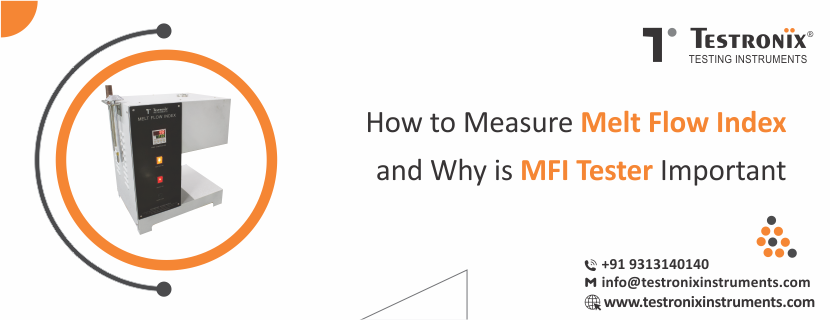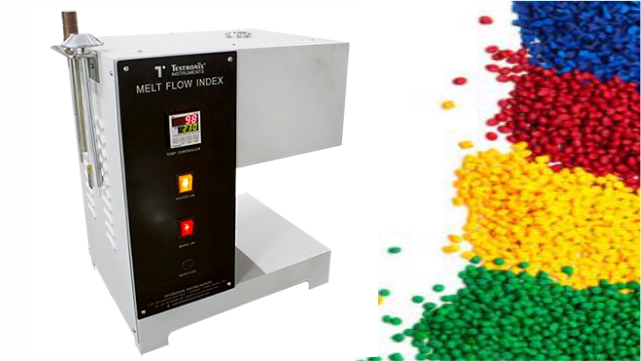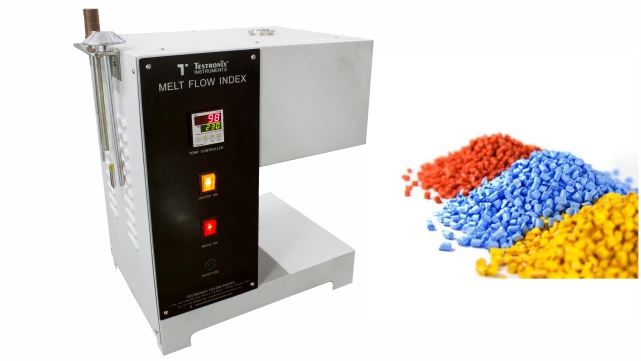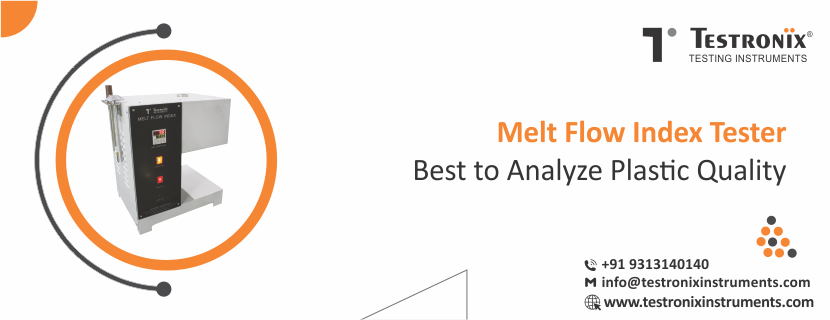Melt Flow Index (MFI) is a measure of the mass of a polymer that flows through a capillary, at a specified temperature and pressure, during a measured time period. Melt Flow Index is typically used to measure the Melt Flow Rate (MFR) of a polymer.
Thus, Melt Flow Index, or MFI, is a standardized measure of the mass of a polymer that flows through a capillary during a set period of time. Melt Flow Index is a measure of the flow rate of a molten polymer and is commonly used to evaluate the quality of a polymer batch.
Melt Flow Rate
Melt Flow Rate (MFR) is the mass of polymer that flows during the test, over a specified time period. Melt Flow Rate is a measure of the ease with which a polymer can be melt processed. Melt Flow Rate can be measured using a Melt Flow Index Tester.
Melt Flow Index Tester
The Melt Flow Index Tester consists of an extruder, die, and motor assembly. The motor assembly drives the screw which propels the polymer through the die. The die orifice size determines the rate at which the polymer flows. The molten polymer exiting the die falls onto a weighing platform where the mass of polymer is recorded over time. The Melt Flow Rate is then calculated from the recorded data. The Melt Flow Index is useful for quality control and determining processing conditions for polymers. It is also used to compare different polymers for their suitability in an application.
Importance of MFI
- Melt Flow Index Testers are used to measure Melt Flow Index and can be found in many labs and quality control facilities.
- The Melt Flow Index can be affected by many factors, such as the type of polymer, the molecular weight of the polymer, the Melt Flow Index Tester settings, and the environmental conditions during testing. Melt Flow Index is an important measure of polymer quality.
- MFI Tester can be used to troubleshoot problems with a production batch or to monitor changes in polymer formulations.
- As mentioned above, Melt Flow Index (MFI) is a measure of the mass of a polymer that flows through a capillary, at a specified temperature and pressure, during a measured time period. Melt Flow Index Tester can be used to measure the Melt Flow Index of a polymer.
- The Melt Flow Index is an important property because it is related to the viscosity of the polymer, which in turn affects the processing of the polymer. Thus, Melt Flow Index can be used to optimize the processing conditions of polymers. Since, Melt Flow Index is also an indicator of the viscosity of the polymer, it can be used to correlate it to study the properties of the polymer. As we know, viscosity is a melted material’s ability to flow when under pressure. Melt Flow Index of a material is inversely proportional to viscosity.
- In addition, Melt Flow Index can be used to classify polymers and to select suitable polymers for specific applications. Melt Flow Index is an important property for many reasons and should be measured when possible.
- MFI can also be used to compare the molecular weight distribution.
Thus, MFI can be correlated to various properties of the polymer such as molecular weight, viscosity and weight distribution.
Key Points For MFI
- The higher the Melt Flow Index of the polymer, the lower its molecular weight.
- MFI is inversely proportional to the viscosity of the polymer.
- Melt Flow Index values of a single material at different gravimetric weights can be used to measure the molecular weight distribution of the polymer under test.
MFI & Molecular Weight of a Polymer
Melt Flow Index is a test that is used to determine the average molecular weight of a thermoplastic polymer. The Melt Flow Index test is performed by heating a sample of the polymer to a specific temperature and measuring the time it takes for the polymer to flow through a small opening. The Melt Flow Index is inversely proportional to the average molecular weight of the polymer; therefore, a high Melt Flow Index indicates a low average molecular weight while a low Melt Flow Index indicates a high average molecular weight. The Melt Flow Index is commonly used as a measure of quality control for plastics since it is directly related to the physical and synthetic properties of the plastic. A high Melt Flow Index indicates that the plastic is of good quality and is suitable for use, while a low Melt Flow Index indicates that the plastic is of poor quality and is not suitable for use
Method of Testing Melt Flow Index
MFI is a measure of the ease with which a thermoplastic polymer melts and flows. The Melt Flow Index value is derived from the rate of extrusion of the molten polymer through a die under prescribed conditions of temperature, load, and orifice diameter. Melt Flow Index is expressed in terms of the weight of polymer in grams flowing out through the die in ten minutes.
Melt Flow Index Test is conducted by loading the sample into the Melt Flow Index Tester at a temperature above its melting point.
- The Melt Flow Indexer consists of an electrically heated outer zone and an inner die.
- The sample is placed in the inner die and allowed to melt completely for a few minutes.
- The Melt Flow Indexer is then turned on and the screw punch starts moving downwards at a constant speed, forcing the molten polymer out through the orifice at the bottom of the die.
- The Melt flow rate is calculated based on the time taken for 10g of polymer to flow out through the die.
The Melt Flow Rate can be used to predict several material properties such as processing behavior, long-term viscoelastic behavior, stability during end use, etc. It is, therefore, an important quality control parameter for many polymers and plastic materials.
So, the Melt Flow Index test is performed in order to assess the suitability of the plastic granule for an application based on its Melt Flow Index. The Melt Flow Index test results are analyzed by the quality control department in order to decide whether or not the sample under test is suitable for use. The Melt Flow Index test is an important tool for determining the suitability of a thermoplastic material for an application.
Benefits of Melt Flow Index Testing
Melt Flow Index Testing is a common method used to evaluate the flow properties of a thermoplastic.
The Melt Flow Index is a measure of the ease with which a material flows and is determined by measuring the rate of extrusion of a molten polymer through a capillary die under specific conditions. Melt Flow Index Testing is typically used for quality control during production, as well as for research and development purposes.
There are numerous benefits to Melt Flow Index Testing, including the ability to compare materials for product development, such as:
- To evaluate samples from new material suppliers
- To estimate flow properties for simple extrusion processes
- To predict a polymer’s behavior for certain processing techniques
- To perform quick comparisons for quality and production control.
- Additionally, Melt Flow Index Testing can be used to verify the conformance of a material to a Certificate of Analysis
- Also, to differentiate between grades of material.
Melt Flow Index Testing is an essential tool for any company that works with thermoplastic materials. Since, the Melt Flow Index Test is very versatile, it has many benefits that make it useful for a variety of applications in product development, quality control, and material selection.
Applications of MFI Tester
Thus, Melt Flow Index Test, also known as Melt Flow Rate (MFR) measure the rate of extrusion of a melted polymer through a capillary of specific diameter and length. The resulting value is expressed as the weight of polymer extruded per unit of time in grams per 10 minutes.
- MFR values can provide helpful information about a material's quality and consistency. For example, a high MFR value indicates a material with good flow properties, while a low MFR value indicates a material with poor flow properties.
- Melt Flow Index Tests are frequently used in the plastics industry to quality control thermoplastic materials.
- Moreover, Melt Flow Index Tests can also have other industrial applications. For instance, Melt Flow Index Tests can be used to determine the lot-to-lot consistency of resin or thermoplastic materials. As such, Melt Flow Index Tests are an important tool for quality control in a variety of industries.
- The Melt Flow Index Test is used to grade thermoplastic materials and determine their quality.
- The Melt Flow Index is a measure of the flow resistance of a material, and as such, it is an important consideration in many industrial applications. For example, the Melt Flow Index can be used to optimize the processing of plastics.
- It can also be used to troubleshoot production problems, and to select materials for specific end-use applications.
- In addition, the Melt Flow Index can be used as a quality control tool to ensure that batches of material meet specifications.
As a result, the Melt Flow Index Test is an essential tool in many industries.
International Standards for Melt Flow Index Testing
Melt Flow Index tests, also known as Melt Flow Rate tests, are an essential quality control measure for many plastic manufacturers. These tests help to determine the flow properties of molten plastics, which is important information for both product design and production.
There are two international standards for Melt Flow Index testing: ASTM D1238 and ISO 1133. These standards define both the equipment specifications and the test methods that should be used.
When reporting Melt Flow Index test results, it is important to include the specific test parameters used, such as weight and temperature. This is because different materials require different conditions for an accurate reading. By following these international standards, manufacturers can ensure that their Melt Flow Index testing is reliable and precise.
These standards are utilized since they define both equipment specifications and test methods. It is important to report the test parameters along with the results. This is mandatory because various weights and temperatures are suggested for different material types.
The Melt Flow Index can also be found by observing the change in weight over time as reported in ISO 11357-3. This standard defines three types of tests; Melt Flow Rate, Melt Volume Rate, and Melt Mass Rate which are all measurements of the same index. The major differences are in the die specifications and weights used. For the Melt Volume Rate Test, ISO 11357-1 is utilized while for Melt Mass Rate Test, ISO11357-2 is referenced. To convert between these rates, disappeared polymers need to be taken into account since they do not exit through the die opening.
Summary
The Melt Flow Index Test is a well-known test used to determine the quality of thermoplastic materials. It is also commonly used to check the consistency of resin or thermoplastic materials from batch to batch. This test is based on the principle that the melt flow rate of a polymer is related to its molecular weight. In general, polymers with a high molecular weight tend to have a higher resistance to flow, while those with a lower molecular weight tend to have a lower resistance to flow. As such, this test is an important tool for those in the plastics industry who need to ensure the quality and consistency of their products.








